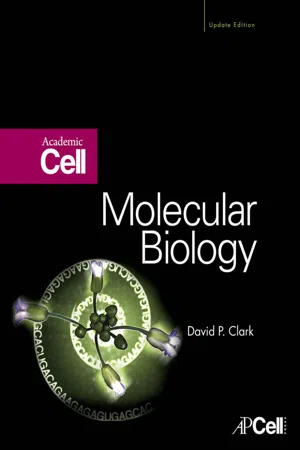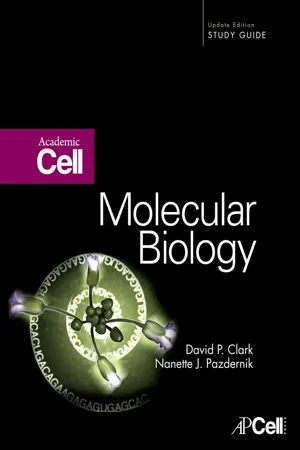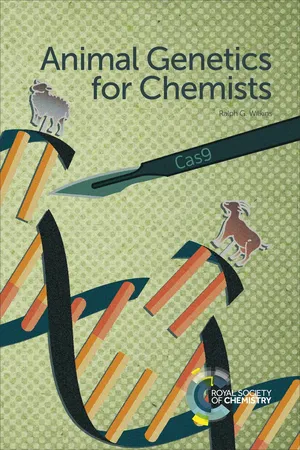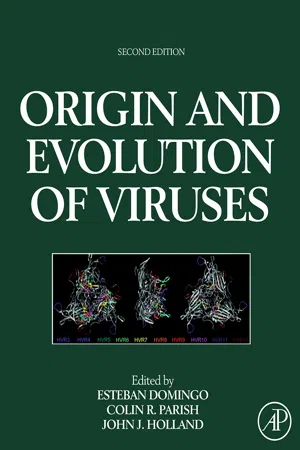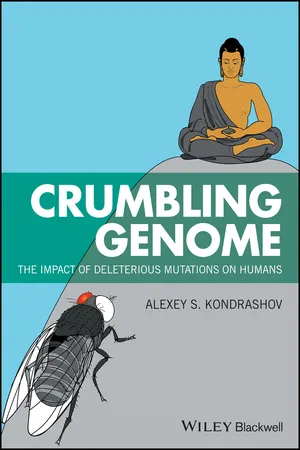Biological Sciences
Harmful Mutations
Harmful mutations are genetic alterations that can negatively impact an organism's phenotype, survival, or reproductive success. These mutations can lead to diseases, disorders, or reduced fitness, and are often eliminated from a population through natural selection. Harmful mutations are a key factor in understanding genetic diseases and evolutionary processes.
Written by Perlego with AI-assistance
Related key terms
5 Key excerpts on "Harmful Mutations"
- eBook - ePub
- David P. Clark(Author)
- 2009(Publication Date)
- Academic Cell(Publisher)
An error in a cell’s genetic material is known as a mutation. As might be expected, many mutations are detrimental. However, detrimental mutations tend to be overestimated because they are more noticeable. Very often the negative effect is minimal, and in fact, the majority of mutations have little or no significant effect on the survival of an organism—they are essentially neutral. Furthermore, occasional mutations may turn out to be beneficial to the survival and reproduction of the organism. The accumulation of such beneficial mutations allows the organism to evolve in response to changing environmental conditions (see Ch. 20). Mutations are heritable alterations in the genetic material of any organism or gene creature. At the molecular level, mutations are alterations in the DNA molecules of which the genes are made. Consequently, when a DNA molecule replicates, any changes due to mutation of the original DNA base sequence will be duplicated and passed on to the next generation of cells. In single-celled organisms, mutations are passed on from one generation to the next when the organism divides. Among multi-cellular organisms, the situation is more complicated. Mutations are inherited by the next generation of organisms only if they occur in the cells of the germ line and are passed on during sexual reproduction. Mutations that occur in somatic cells will only be passed on to the descendents of those cells. Such mutant cell lines will be restricted to the original multi-cellular organism where the mutation occurred. Somatic mutations that result in unregulated cell growth are responsible for the emergence of cancers. Other somatic mutations merely result in particular cell-lines or organs being genetically different from the rest of the body. Since the DNA is used as a template in transcription to make an RNA copy, a mutation in the DNA sequence within a cell will be passed on to the mRNA molecule. Finally, the mRNA is translated to yield protein - eBook - ePub
Molecular Biology
Academic Cell Update Edition
- David P. Clark(Author)
- 2012(Publication Date)
- Academic Cell(Publisher)
CH 13 MutationsSummary
Mutations are alterations in DNA, the genetic code. Mutations have a bad connotation because we tend to notice all the deleterious ones, but many mutations can give an organism an advantage. In fact, mutations are what underlie basic evolution, providing a way for organisms to live longer, reproduce faster, or survive in harsh environments. In order for a mutation to propagate and give a species an advantage, then it must occur in reproductive cells or gametes. In humans, deleterious mutations in reproductive cells result in inherited diseases.Since even a single change in nucleotide sequence can have multiple effects on phenotype, there are a lot of categories for mutations. In point, where there is only a single nucleotide change, sometimes there can be no effect, sometimes the mutation will totally inactive a gene (null mutation), or some sort of gray area between the two extremes. Another possible effect of some changes is leaky mutations that only allow partial enzyme activity, or tight mutations that have one clear-cut phenotypic change.Mutations can be caused by base substitutions, insertions, deletions, inversions, duplications, and translocations of DNA. The simplest change is base substitutions that occur during replication, where the wrong complementary base is inserted. Although most of these mistakes are corrected, some are missed by repair enzymes which can then propagate into subsequent daughter cells. Transitions are substitutions that change a pyrimidine to another pyrimidine (switch T for C or C for T) or purines to another purine (switch G for A or A for G). Transversions switch purine for pyrimidine or vice versa, switching T for A for example.The location of a transversion or transition determines whether or not the mutation has a positive effect, negative effect, or no effect at all. If the substitution occurs in a protein coding region, then the change could change the amino acid code, resulting in a missense mutation, where one amino acid is replaced by another. Conservative mutations change one amino acid to one of similar chemical properties, such as serine to threonine, which usually does not affect the overall function of a protein. In contrast, radical substitutions or radical replacements occur when the missense mutation makes a change that alters the size and chemistry of the amino acid. These can have a huge effect on protein function. A temperature sensitive (ts) mutation occurs when the missense mutation makes the protein functional at one temperature called the permissive temperature, but unable to function at warmer temperatures (restrictive), such as the fur coloration in ferrets. A conditional mutation is defined as one that varies protein function depending on environment, for example, changes in pH or cold temperature affect whether the mutation changes phenotype or not. Some missense mutations actually change the amino acid codon into a stop codon, and these are categorized as nonsense mutations. They cause ribosomes to stop translation, so they are also called chain termination mutations. - eBook - ePub
- Ralph G Wilkins(Author)
- 2017(Publication Date)
- Royal Society of Chemistry(Publisher)
CHAPTER 4 DNA Mutations and Their Impact on Human and Animal Phenotypes4.1 INTRODUCTION
This is a very important chapter encompassing all the varied changes that DNA can undergo and thereby produce faulty (mutant) genes and protein products. At the center of genetics, a mutation involves a functional change in the genetic material of a cell, specifically a change in the DNA or RNA sequences, and thus affects the sequence of amino acids in the resulting protein. If the change does not affect this sequence, it is a natural variant. A mutation is not necessarily irreversible, but if it involves somatic cells (acquired mutations), these will disappear when the owner dies. However, if the mutation involves the reproductive cells (germline mutation), an offspring may inherit the mutation in all its cells and have a hereditary ailment (inherited mutation). If after conception, growth and development of an embryo, only some cells have the mutation, mosaicism results.The frequency of mutations is rare and may be inherited or acquired during a person’s lifetime. Only a very small percentage of mutations cause genetic disorders, usually by altering or removing a critical encoded protein. The animal affected by the mutation (the mutant) may have discernible changes in the resulting phenotype, that is in its appearance, behavior or traits (disorders or diseases) compared with the wild-type animal, which has the phenotype most common in nature. The intensity of the phenotype change is likely to depend on the magnitude of the mutation, namely how much the DNA is changed or the chromosome involved. The mutation may arise as a random event during the formation of the egg or sperm, or in the early embryo (see Section 5.3 in Chapter 5 ), in which case there will have been no history of the disease in the family. Alternatively, it may be inherited from an affected parent.4.2 TYPES OF MUTATION
There is a wide range of types of alterations in DNA that lead to a mutation. Slight changes, involving only one or a few nucleotides, can only be detected by full sequencing techniques. On the other hand, whole chunks of DNA, involving millions of base pairs and even entire genes, may be lost or moved around within a chromosome or between chromosomes. These may be detected using karyotype patterns or by spectroscopic techniques (see FISH and SKY in Section 1.4.3 in Chapter 1 - eBook - ePub
- Esteban Domingo, Colin R. Parrish, John J. Holland(Authors)
- 2008(Publication Date)
- Academic Press(Publisher)
CHAPTER 9 Lethal MutagenesisJames J. Bull, Rafael Sanjuán, Claus O. WilkeABSTRACTMost mutations with phenotypic effect are harmful, and an increase in mutation rate generally leads to a decrease in population fitness. This relationship lies at the heart of the concept of lethal mutagenesis, whereby a viral population is driven to extinction through the administration of a mutagen. Here we explain the theoretical basis for lethal mutagenesis, describe how lethal mutagenesis differs from Eigen’s error threshold, and show that experimental results on lethal mutagenesis are consistent with theoretical expectations. The most important insight derived from the theory of lethal mutagenesis is that extinction arises from a combination of genetic and demographic processes, so that there is no hard mutation threshold at which extinction is guaranteed, and no genetic signature that distinguishes lethal from non-lethal mutagenesis. Another important property is that the decline in population fitness following an increase in mutation rate may happen slowly. Thus, elevation of the mutation rate to a level sufficient to cause extinction may be followed by many generations before population size begins to decline.INTRODUCTION
Lethal mutagenesis is the concept and practise of elevating the mutation rate of a virus to the point that the viral population dies out. This is potentially a workable mechanism for an infection within one host, where drugs can be applied in sufficient concentrations to elevate mutation rates above background. Nearly a century of work in genetics has shown that most mutations with phenotypic effect are harmful, many even being lethal, so there is little question that lethal mutagenesis can work in principle. The question is then the quantitative one of just how much elevation is required. Our chapter addresses the quantitative basis of lethal mutagenesis. - eBook - ePub
Crumbling Genome
The Impact of Deleterious Mutations on Humans
- Alexey S. Kondrashov(Author)
- 2017(Publication Date)
- Wiley-Blackwell(Publisher)
4 Unavoidable MutationIn short, mutations are accidents, and accidents will happen.Alfred H. Sturtevant, 1937.The ultimate cause of all genetic variation is mutation, the appearance of random errors in DNA sequences. Most of individual mutations affect only short segments of genotypes, and single‐nucleotide substitutions and short deletions or insertions are particularly common. However, occasionally a mutation affects a very long DNA segment. Mutations can appear as singletons or as clusters. Under normal conditions, most mutations occur spontaneously, due to unavoidable errors in the course of DNA replication, repair, or recombination, and are not caused by any external influences. Apparently, natural selection tries to keep the rate of germline mutation in multicellular organisms as low as possible, without incurring too high a cost of DNA handling. It is not difficult to induce mutations by radiation or, even more efficiently, by chemical mutagens; in contrast, all attempts at germline antimutagenesis have been so far unsuccessful. Tools for active antimutagenesis by means of deliberate genotype modification are now in the early stages of development.4.1 Phenomenon of Mutation
In the review of genetics, presented in the previous three chapters, it was mentioned in passing that polymorphic loci originate as a result of mutation. This phenomenon is the root cause of the Main Concern, and now it is time to treat it in detail. Most generally, mutation (from the Latin mutatio meaning an alteration) is a process of appearance of changes in genotypes. Due to the discrete nature of DNA sequences, mutation consists of separate events, and each such event is also called a mutation. To add to the confusion, a new, altered, mutant DNA sequence, which emerges as the result of a mutation, is also called a mutation (Figure 4.1 )! And an individual that carries a de novo
Learn about this page
Index pages curate the most relevant extracts from our library of academic textbooks. They’ve been created using an in-house natural language model (NLM), each adding context and meaning to key research topics.
